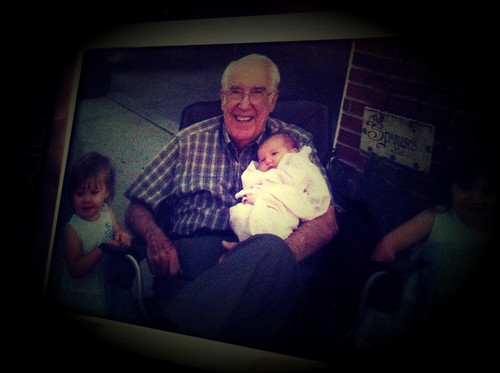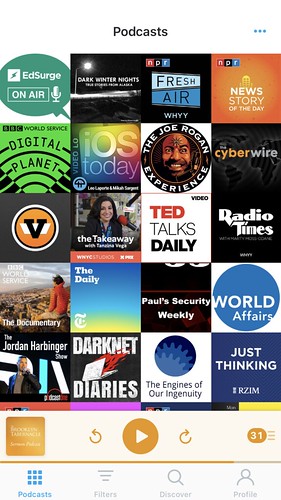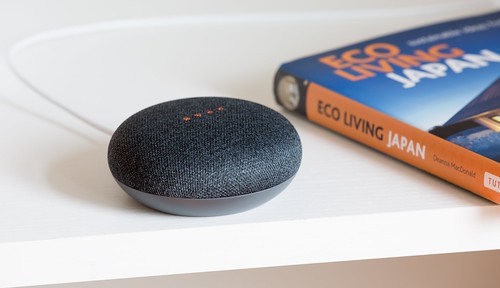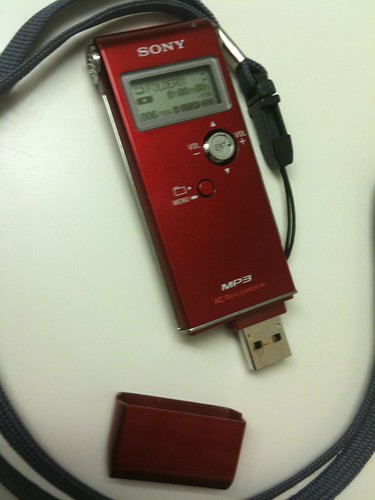11
Thanks to smartphone apps and inexpensive digital recorders, audio recordings are easier than ever to create and share with others. Whether you are sharing a reflection or a memory, interviewing a loved one or member of your church who just got back from a mission trip, or recording a class or lecture, audio recordings can be a great medium to share ideas about the Gospel of Jesus Christ.
Since all modern smartphones allow users to readily capture video as well as photos, you might wonder why an audio recording can be preferable to a video? Some of the reasons are:
- Audio recordings have fewer variables to plan for and control.
- Some people feel less intimidated speaking into an audio recorder rather than a video camera.
- Video file sizes can be large, especially for longer recordings, which can present challenges in uploading and sharing.
Christian Audio and Podcast Examples
As with other kinds of media projects, one of the best ways to understand the power and beneficial potential of audio recordings for “Christian digital storytelling” is to listen to some examples. Several years ago, I worked with “youth deacons” at our church to record a series of interviews with older members. These interviews are archived on a website titled, “Faith Stories: Audio Interviews about Christian faith and mission work.” (faithstories.speedofcreativity.org) Some of the great things about these recordings and this project are:
- No one imposed a time limit on these recordings: Some are short, and some are long. Some are in multiple parts.
- These audio interviews are a digital record of the lives and experiences of different people in our church. Some of those interviewed have since passed away. They can no longer share about their lives as followers of Jesus in person, but these audio recordings of their memories live on. This has tremendous value to the family and friends they left behind, and can be inspirational to anyone connected to the Internet who has the link to their recordings.
I encourage you to listen to some of the “Faith Stories” interviews to better understand the possibilities simple audio recordings can offer, especially “amateur” recordings like these which are simple yet powerful for the reasons noted above.[1] In conducting and supervising these interviews over the years, I found it can be helpful (especially when interviewing older adults) to invite a close member of their family to be present. Photo albums can also help trigger memories. Family members can ask for additional elaboration on stories, or draw out details from experiences which the interviewee might otherwise neglect to mention and leave out of their stories.
Here are two examples from that project, recorded in 2011.
Oren Lee Peters was born on April 16, 1921, on 2nd Street in Edmond, Oklahoma, and grew up in our church (First Presbyterian Church of Edmond) on 15th Street. I recorded an extended interview with him in April 2011, when he was 90 years old.[2] Part one is 3 hours and 17 minutes long, part two is 44 minutes long. From stories he was told by his grandparents about the Oklahoma Land Run” in 1889, the dust bowl era in Oklahoma, to his experiences in World War II on the beaches of Italy during the Allied invasion, to stories about being a Boy Scout and Scout leader for decades in Oklahoma, this is an amazing record of a life well lived. Oren Lee is a member of the Oklahoma Military Hall of Fame.[3] He also has an extensive memory of the history of Edmond, Oklahoma, from before the founding of the state in 1907 (from memories of stories his family told him) to the present day, which was 2011 at the time of this recording. Oren Lee also shared about his faith in the course of this interview, including an unforgettable time of prayer to God when he was in a desperate situation in Italy under enemy fire. In a real situation which sounds like a scene from the movie, “Saving Private Ryan,” U.S. aircraft miraculously appeared after his desperate prayer and strafed the enemy positions, enabling U.S. forces to advance and Oren Lee to live another day. This extensive interview with Oren Lee touches on many topics and eras of history, but his “testimony of faith” is certainly one of the most personally memorable parts which I will never forget, and for which I am thankful to have been able to hear from him as well as share with others as a digital witness. To better share and preserve this oral history interview, I’ve also shared this on YouTube.[4] I used Audacity software (www.audacityteam.org), the Auphonic web service (auphonic.com), and the iPad app “Voice Record Pro” to export these audio recordings as a video for YouTube.
Another powerful example of “Christian Digital Storytelling” from this interview archive is the three part series with Ella Mae Miller from 2008. (Part 1: 28.5 min, Part 2: 25 min, Part 3: 27 min.) Ella Mae was born in June 1918, and was a long-time member of our church who was one of the first U.S. Christian missionaries in Iran in the late 1940s and 1950s. She passed on from this life to be with our Lord in 2019. Listening to this 81 minute interview with her at age 90 is a wonderful gift, and a powerful testimony to the ways God works in our lives to share the love of Jesus Christ with others around the world.[5]
A wealth of more professional audio podcast examples are also available which demonstrate the power recorded audio for Christian evangelism and edification of believers. “Pray as You Go” (pray-as-you-go.org) is a daily audio devotional maintained the Jesuits of Britain. Its daily audio files are available online and as an app for iOS and Android. One of my favorite sermon podcasts is from The Brooklyn Tabernacle, featuring the latest sermons by Pastor Jim Cymbala. Since I first drafted this chapter the link to those online sermons has been updated. As of December 2020, it is media.brooklyntabernacle.org.
Audio versions of The Bible are also available on multiple websites and mobile apps. The YouVersion Bible app (www.youversion.com/the-bible-app) and online Bible (my.bible.com) are my favorites which provide free audio versions of multiple audio translations of the Bible on different platforms: smartphones, tablets and computers.
Listening to Podcasts: Podcatching
Before describing the steps and tools for creating a podcast, it’s valuable to highlight different ways people are listening to podcasts. The popularity of Apple’s iPhone smartphone has made the iOS built-in Apple Podcasts app a primary way many people find and “subscribe” to podcasts, but it is certainly not the only way. The author’s favorite podcast listening or “podcatching” smartphone app is Pocketcasts. (www.pocketcasts.com) It’s free and available for both iOS and Android devices.
By “subscribing” to a podcast, users can readily find and download recent or any archived episodes from the show’s “feed.” Podcast shows updated most recently are shown at the top of the app’s homescreen by default, and users can tap on a podcast and either download it locally (so it can play offline even when Internet access is not available) or stream it directly from the web.
“Smart speakers,” like the Amazon Alexa series and Google Home series, allow us to now play podcasts by simply saying the name of a podcast which is listed in the speaker’s online, updated directory. As an example, a few years ago I started a new podcast channel on Anchor.fm called, “Class with Doctor Fryer.” [6] To listen to this podcast on a Google Home, you can say:
Hey Google. Play the latest episode of Class with Doctor Fryer.
While smart speakers are not ubiquitous in homes today in the United States or in other countries, smart assistants like “Siri” on iPhones / iOS / MacOS devices and “The Google Assistant” on Android phones as well as iOS devices (via an app) are very common in late 2020. Being able to ask our smart phones, smart watches, and smart speakers to do things for us (like play podcast episodes) feels a little bit like stepping onto the set of a Star Trek episode. Because of a variety of factors, including rapidly improving “speech to text” and voice recognition technologies powered by machine learning, this method of listening to podcasts is becoming both easier and more common.
“Podcasting” started around 2005, but the availability of smart phones, faster data speeds on mobile phone networks, and generally more ubiquitous Internet access in many homes and workplaces offers greater potential than ever for people to both listen to and create / share audio podcasts. If you are not already, consider listening to and subscribing to some podcasts, using either your smartphone, smart speaker or digital assistant. I maintain a periodically updated lists of podcasts to which I subscribe on wiki.wesfryer.com/podcasts, and you may find some podcast titles of interest which you can not only enjoy consuming, but also use to analyze as you consider what makes audio podcasts both effective and enjoyable. [7]
Terminology
The term “audio podcast” sounds geeky, and this can be a turn-off for some folks. I’ve been using the term “radio show” instead of “audio podcast” in my educational technology work with teachers and students the past few years, and it seems to be received with less confusion and fear. This is important. Although more people know about and use “podcasts” today by name, it can be simpler to explain to someone you want to interview that you’re creating “a digital audio interview to share on the Internet.”
Podcasts and podcasting continue to grow in popularity. Research in early 2019 indicated 70 percent of U.S. households reported familiarity with podcasts, with just over 50 percent reporting they listened to a podcast in the past month. Increasing numbers of people are listening to podcasts, across all demographic groups in the United States.[8] The number of people familiar with podcasts grew to 75% of U.S. households in early 2020. [9]
Faster cellular data transmission speeds in more areas, the growing adoption of smartphones with “podcatching” / podcast apps which support listening and subscribing, as well as the availability of home “smart speakers” which support podcasting listening are all contributing to the burgeoning popularity of podcasts.
Whatever term you choose to use, an audio podcast is a pre-recorded audio file available for on-demand listening, usually featuring different segments (or spots) combined into a single program. This is an MP3 audio recording of a Sunday School class podcast I created with 4th and 5th graders in July 2008. I posted this to the BLASTcast Podcast site on WordPress.com.[10] While the website where that podcast is linked is hosted (for free) by WordPress.com, the actual podcast is not. In this case, the podcast is hosted in the Amazon cloud, via “Amazon S3″ (simple storage service.)
Podcasting involves a multi-step workflow. While some mobile apps / websites like Anchor.fm handle all aspects of the podcasting process, many podcasts and podcasters use a variety of tools and software programs to create podcasts.[11] My blog post from 2015, “Conference Podcast Recipe and Workflow,” breaks down the podcasting process into five primary steps:[12]
- Record
- Edit
- Export
- Upload
- Link
These steps can be further simplified (and perhaps easier to remember and share, since each word starts with “P” using these steps, which I shared in the September 2019 podcasting conference keynote, “Who Tells Your Story?”[13] The steps are:
- Planning
- Production
- Post-Production
- Publishing
Audio podcasting CAN be complicated, but the availability of different mobile applications (apps) as well as websites can streamline these processes. There are benefits as well as drawbacks to streamlined audio podcasting, however, including the questions:
- Who hosts your audio files? (Where are your audio files shared online for others to access?)
- Does continued availability for others to access and download those files rely on you paying a SUBSCRIPTION FEE to a company?
- Will your audio files be hosted perpetually for free? (The Internet Archive (archive.org) and YouTube are two locations where podcast files (in the case of YouTube, uploaded in video format) can be hosted for free, potentially indefinitely.) [14]
Sharing Basic Audio Recordings
Before exploring ways to listen to as well as create “true podcasts,” which are shows or “channels” featuring multiple episodes to which listeners can SUBSCRIBE, let’s explore how individual audio recordings can be created and shared online. This presents a two-part challenge, since it is necessary to both:
- Record the audio interview, event or presentation
- Upload the recorded file somewhere on the Internet so it can be accessed by others via a link
Let’s first address audio recording.
Before the release of the iPhone in 2007 and the era of powerful, Internet connected smart phones, battery operated, digital audio recorders were my preferred tool for podcast recording. These recorders are still available and offer multiple benefits, but the workflow to use them can still be more cumbersome and time consuming compared to a smartphone app.
Battery operated, portable digital audio recorders can:
- Run for hundreds of hours without a need to recharge
- Get more power simply by replacing their batteries (usually either AAA or AA size) instead of plugging into a power source
- Operate without a need for an Internet connection
- Operate without the interruption risk of a smartphone, which can receive a phone call, text message, or other notification if those features are not turned OFF during audio recording
When our daughter went to France on an exchange student trip in March 2022, we went her with a digital audio recorder because of these comparative benefits to a smartphone recording app. Sony has a variety of digital audio recorders which are reasonably priced, the “Sony 4GB PX Series MP3 Digital Voice IC Recorder With Built-In Stereo Microphone” is $50 US (as of this writing) and is a favorite model of the author. If you’re wanting a more advanced audio recorder and have a larger budget, digital audio recorders by Zoom are worth checking out.
Just as they saying “the best camera is the one you have” can be true, meaning your smartphone camera is often a “go-to choice” for mobile photography, the same thing is true for mobile audio recording. Compared to a dedicated digital audio recorder, Smartphones and an audio recording app offer the following features for recording audio interviews:
- Generally readily available
- In the case of iPhones and iOS devices especially, they generally have a good quality built-in microphone
- Can record using a variety of free as well as paid apps
- Can transfer recorded files electronically to other devices and people directly via the Internet
Sharing the specific name and link to an iPhone app risks obsolesce since technology changes so quickly. Acknowledging this, I’ll recommend the free iPhone app “Voice Record Pro” as one of the most useful and flexible audio recording smartphone apps available as I write this in early 2022.[15] The five minute video tutorial, “Record a Podcast on an iPhone with Voice Record Pro,” highlights the basic features and steps for using the app to record and share an audio interview.[16] Before iOS 12 on iPhones when the “Files app” was added, it was challenging to save and share audio recordings. Even though this is easier today, the capability of the free “Voice Record Pro” app to export recorded audio files as VIDEOS saved to the iPhone camera roll is a wonderful feature. I frequently use Voice Record Pro to record audio presentations and class lessons I share, since it’s not only easy to record but also share with others as well as online.
The free iOS app Anchor has become (as of 2021) a popular and powerful iOS app for not only recording audio, but also EDITING and SHARING / publishing it online.[17] Anchor is now owned by Spotify, but audio recordings / podcasts you record and edit with the app do NOT have to necessarily be published online via the Anchor web hosting platform. [18]Given that the web sharing / web hosting aspect of podcasting is often the most complicated and the step with which many aspiring podcasts struggle, Anchor’s provision of FREE web hosting for podcasts can be a wonderful feature. More details and tutorials about using Anchor as a podcast creation app are included later in this chapter.
Creating a Podcast: Workflow
The following photo is a storyboard or podcast “lineup” for a 5th Grade Sunday School audio podcast I helped students create back in 2011 about “How and Why to Pray.” Unfortunately, we shared that audio file on a website that is now offline (Cinch.fm) so the actual mp3 file is lost to history.
Back in April of 2007, I created a “Planning Guide for Christian Podcasters” (PDF) which can serve as a storyboard for podcasts.
Two of my favorite iPhone apps for recording audio interviews and audio podcast segments are “Ferrite Recording Studio” and “Voice Record Pro.” The free version of Ferrite supports recordings up to 60 minutes long, and these can be readily exported and shared to a laptop or desktop computer, or iPad, for further editing if desired. Voice Record Pro allows a photo or an image with the episode title and notes to be exported as a VIDEO to the iPhone or iPad’s Camera Roll. From there, it can be directly uploaded to YouTube or shared on other websites as a video. Voice Record Pro is free (despite the word ‘Pro’ in the name) and is available for both iOS and Android smartphones.
While app-based audio recording can be safer and more flexible, since apps can record “offline” without a stable Internet connection, free Internet-based audio recording web tools are also available. The online version of Twisted Wave (twistedwave.com/online) supports browser-based audio recording on any device with a modern web browser. Recordings can be exported and saved locally, or exported to a cloud-based file storage service like Google Drive. In my “Family Oral History” media literacy unit for 5th and 6th graders, I teach students how to use both TwistedWave online and Voice Record Pro to record and share audio interviews.[19] Regardless of the Internet-connected technology device you have, if it has a microphone, it should support both recording and sharing digital audio recordings.
To make and share a “true podcast,” which is a “subscribable, multi-episode collection of audio recordings,” I recommend using the free app and website Anchor.fm. In September 2019, I keynoted a podcasting conference in Oklahoma City and shared a breakout session with resources specifically focused on using Anchor to start a podcast.[20] Anchor not only provides free apps for iOS and Android to record and edit audio podcasts, Anchor also provides a web interface for audio editing and publishing. Copyright-friendly audio “bumpers” are also available within the app, and other features too. Anchor is fantastic!
More resources about creating audio podcasts are available on the “Audio Interviews” page of ShowWithMedia.com.[21]
In March 2021, I created the slideshow, “Tips for Student Podcasting Projects with Anchor,” in my role as an instructional coach at our school working with other teachers interested in using podcasting in the classroom with students.[22] Whether you are creating an audio podcast by yourself or facilitating podcast creation by others, the slides in this presentation provide a good overview of the terminology, tools, and workflow for creating and sharing true audio podcasts.
Here are my tips for the four different phases of audio podcast production which I shared in this presentation.
1. Planning
Like a good written essay, a podcast has an introduction, a body, and a conclusion. The different parts of a podcast are sometimes called “segments” or “corners.” It’s important to “hook” your audience early by letting them know why they should continue listening to the podcast, and engaging them with the ideas and topics you’ll be highlighting in greater depth in the episode.
Storycorps (storycorps.org) is a wonderful organization focused on empowering storytellers and the sharing of stories, and hosts an excellent resource which can be helpful in the podcast planning process: “The Great Questions List.” [23] It is best to share your planned questions in advance with the person who you are going to interview, if possible, to give them an opportunity to think in advance about their answers. This also can provide them with an accurate idea of what to expect in the interview, as far as the main questions you ask and want to discuss.
Production
Post-Production
Sharing
- The "Faith Stories" audio interviews are hosted on a web server maintained by the author, Wesley Fryer, and shared using the open source software, "Podcast Generator." (www.podcastgenerator.net) ↵
- Fryer, Wesley. “Oren Lee Peters – Stories of My Life.” Moving at the Speed of Creativity, 15 Sept. 2011, www.speedofcreativity.org/2011/09/15/oren-lee-peters-stories-of-my-life/. ↵
- Oklahoma Military Hall of Fame: Oren Lee Peters. www.okhistory.org/historycenter/militaryhof/inductee.php?id=25. Accessed 23 Dec. 2020. ↵
- Wesley Fryer. Interview with Oren Lee Peters of Edmond, Oklahoma (April 2011). 2020. YouTube, www.youtube.com/watch?v=-Lo9e9s0gAk. ↵
- Wesley Fryer. Interview with Ella Mae Miller (Fall 2008). 2020. YouTube, www.youtube.com/watch?v=dqtRAZLdINM. ↵
- “Class with Doctor Fryer • A Podcast on Anchor.” Anchor, anchor.fm/drfryer. Accessed 23 Dec. 2020. ↵
- Wesfryer - Podcasts. wiki.wesfryer.com/podcasts. Accessed 23 Dec. 2020. ↵
- Beniamini, Nicole. The Infinite Dial 2019. 2019, p. 62. www.edisonresearch.com/wp-content/uploads/2019/03/Infinite-Dial-2019-PDF-1.pdf ↵
- Research, Edison. “The Infinite Dial 2020.” Edison Research, 19 Mar. 2020, www.edisonresearch.com/the-infinite-dial-2020/. ↵
- Boldly, Eyes Right ». Blog Archive ». Praying, et al. “BLASTCAST: Pray Boldly and Persistently (Luke 11:9-10).” BLASTcast, 20 July 2008, blastcast.wordpress.com/2008/07/20/blastcast-pray-boldly-and-persistently-luke-119-10/. ↵
- Wesley Fryer. Record a Podcast on a Smartphone with Anchor. 2019. YouTube, www.youtube.com/watch?v=w_XjhvV_w-8. ↵
- Fryer, Wesley. “Conference Podcast Recipe and Workflow.” Moving at the Speed of Creativity, 26 Apr. 2015, www.speedofcreativity.org/2015/04/26/conference-podcast-recipe-and-workflow/. ↵
- Fryer, W. OKC Podcasting Conference - Keynote, 14 Sep 2019. https://sites.google.com/view/podcastingokc/keynote. Accessed 1 Sept. 2021. ↵
- “The Internet Archive - Accounts - A Basic Guide.” Internet Archive Help Center, help.archive.org/hc/en-us/articles/360016378232-Accounts-A-Basic-Guide-. Accessed 23 Dec. 2020. ↵
- “Voice Record Pro.” App Store, https://apps.apple.com/us/app/voice-record-pro/id546983235. Accessed 14 Oct. 2021. ↵
- Wesley Fryer. Record a Podcast on an iPhone with Voice Record Pro. 2019. YouTube, https://www.youtube.com/watch?v=Y2Y7W7FGD5c. ↵
- “Anchor.” App Store, https://apps.apple.com/us/app/anchor/id1056182234. Accessed 14 Oct. 2021. ↵
- “Spotify Says It Paid $340M to Buy Gimlet and Anchor.” TechCrunch, https://social.techcrunch.com/2019/02/14/spotify-gimlet-anchor-340-million/. Accessed 14 Oct. 2021. ↵
- Middle Division Technology - Family Oral History Interview. https://web.archive.org/web/20210405105322/https://mdtech.casady.org/lessons/family-oral-history-interview. Accessed 5 Apr. 2021. ↵
- OKC Podcasting Conference. https://sites.google.com/view/podcastingokc/. Accessed 16 Dec. 2019. ↵
- “Audio Interview.” Show What You Know with Media, 3 Feb. 2012, https://showwithmedia.com/audio-interview/. ↵
- “Tips for Student Podcasting Projects with Anchor by @wfryer (29 March 2021).” Google Docs, https://docs.google.com/presentation/d/1zGoUBZDOmCmX5MkBaHzOK8XBSEw2uiqRVeh2n5VHZ5o/edit?usp=sharing. Accessed 5 Apr. 2021. ↵
- “Great Questions List - StoryCorps Archive.” The Great Questions List - StoryCorps Archive, https://archive.storycorps.org/great-questions-list/. Accessed 1 Sept. 2021. ↵









